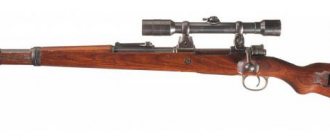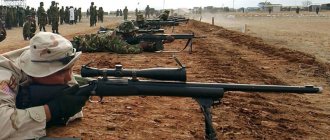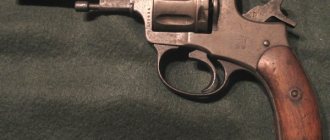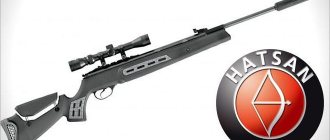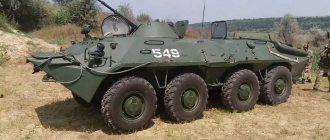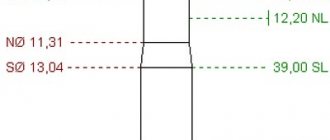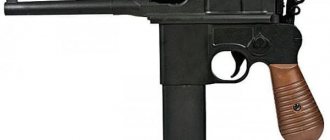History of the appearance of weapons
by the beginning of the twentieth century it already had great fame and popularity - it was not only a successful developer, but also supplied its weapons to many countries. Its rifles and pistols were in service not only with the German army, but also in Spain, Turkey, Belgium, many countries in Europe and the Americas. The reasons for this popularity lay in the firepower, convenience, unpretentiousness and versatility that were outstanding at that time. In addition, they could easily be converted to the required cartridge without any effort. Mauser rifles were used in most conflicts of that time - the Anglo-Boer War, clashes in colonial Africa, India, and the Middle East.
In 1898, a new development was presented - the G98 rifle, which was immediately adopted by the Kaiser's army. It was this rifle that became revolutionary, since in one form or another it served in both world wars, was supplied en masse to many countries of the Nazi bloc, and even now it can be found in many places. It was produced under license in Austria, Czechoslovakia, Poland, Yugoslavia and a number of other countries. Nowadays, both the original rifles and samples created based on their design are still popular, although mainly as hunting weapons.
Of course, the 1898 Mauser rifle was not the only one in the family. In parallel with it, the Kar.98 carbine was also produced. Its design remained unchanged until 1904, when the entire system was redone. This happened in connection with the adoption of a new 7.92x57 mm cartridge, which had a pointed bullet instead of a blunt one. The changes made had a positive effect on ballistics, as a result of which the sights on all rifles were re-calibrated for longer distances. 1908 saw the development of a newer version, the G98. Now it has become much shorter, has a bolt handle curved downwards, as well as a modified muzzle part of the barrel with a hook. This modification (K98a) lasted until Adolf Hitler came to power in Germany. In 1935, the design was redesigned again and received the name K98 kurz (short). This model was adopted as the individual weapon of the German infantry. It served in this form until 1945. Before this period, the industry of the countries of the Nazi bloc produced a colossal number of rifles - several million. Among the improvements made to the design were new-style belt fastenings, a more durable front sight (in the front sight) and a number of other little things that increased ease of use. Many rifles written off after the war migrated to the civilian market, and they are still being sold. They even appeared in Russia, however, converted to the .308 Winchester cartridge (7.62x51 mm), and received the name KO-98.
Combat use
Mauser 98K rifles were widely used by all branches of the German armed forces during World War II. They were used in all theaters of military operations involving German troops, including Europe, North Africa, and the territories of the Soviet Union. As an individual small arms infantry weapon, the Mauser, for all its positive qualities, was relatively cumbersome and inconvenient for combat at close ranges.
The rate of fire from the Mauser 98k was limited by how quickly the shooter could operate the bolt and load the magazine, the small capacity of which significantly reduced firepower. During the same period, the armed forces of Germany's main enemies received self-loading rifles that had a significantly higher rate of fire: the United States massively supplied its army with M1 Garand rifles, and Soviet troops received the SVT-40.
The Germans at the beginning of the war relied more on single MG-34 machine guns for firepower, as well as on the use of Wehrmacht units armed with MP-38 and MP-40 submachine guns. Self-loading rifles began to be produced later, but the Gewehr 43 was not very successful, and the Sturmgewehr 44 could no longer be produced in sufficient quantities. As a result, the Mauser 98K was produced until the last days of the war, remaining the main weapon of the Wehrmacht.
Additional accessories
During World War II, several additional devices were adopted for the Mauser 98k rifle, which significantly expanded the combat capabilities of this weapon.
The main ones:
- The standard Gewehrgranat Geraet 42 rifle grenade launcher was attached to the barrel using a folding clamp. The maximum firing range from it was up to 250 meters. 7 different types of grenades were used as special ammunition;
- The GG/P40 (Gewehrgranatgeraet zur Panzerbekämpfung 40) anti-tank grenade launcher was developed for paratroopers and produced in a small batch. It was lighter and smaller than the standard GG 42 and was attached to the rifle like a bayonet;
- Winter trigger (German: Winterabzug) is a device designed to make rifle shooting easier in winter. Developed in 1942, officially adopted in 1944. It was widely used by snipers because it allowed them to shoot in winter without taking off their gloves. The “winter trigger” was a tin container with a lever inside that fit onto the trigger safety guard. By turning the outer trigger back, the shooter carried out the descent. A similar device was used on the MP 40 submachine gun;
- Silencers. Two types of them have become famous: 23 and 25.5 cm long with a spiral surface. They were put on the barrel using a clamp, similar to the mount for a barrel grenade launcher;
- Krummlauf - a device for shooting from behind cover, capable of turning the bullet's travel by 30 degrees. It was attached to the rifle barrel using the same mechanism as the barrel grenade launcher. Developed in 1943, but after the production of several prototypes, they then tried to adapt them to new assault rifles.
Karabiner 98k sniper with ZF4 scope and winter trigger
Sniper use
The Wehrmacht used standard Mauser 98K rifles as snipers. During factory tests, specimens that gave maximum accuracy were selected from the batch, as was done during the First World War (with conventional Mauser 98 rifles). In addition, SmE (Spitzgeschoss mit Eisenkern, a pointed bullet with a steel core) cartridges were used for sniper shooting.
The first telescopic sight officially adopted by the Wehrmacht was the ZF 39 (Zielfemrohr 1939). In 1940, this sight received a standard graduation for a distance of up to 1200 meters. It was installed above the bolt; during the war, the mounting design was repeatedly improved.
In the summer of 1941, the ZF 41 sight, also known as the ZF 40 and ZF 41/1, was adopted, and at the end of the same year, Mauser 98k carbines equipped with it began to enter the army. With a length of 13 cm, it provided only one and a half times magnification; it was attached to the left side of the rear sight, so it did not interfere with loading the magazine from the clip. Such a sight could only be used for medium-range shooting, and Mausers equipped with it were considered a “rifle for high-precision shooting,” and not snipers. Their production continued until the end of the war.
The ZF 4 telescopic sight (or ZF 43, ZFK 43 and ZFK 43/1) was originally intended for the G43 semi-automatic rifle and was a copy of the Soviet sight, which ultimately had to be adapted to the K98k rifle. The sight was placed above the bolt on an arrow-shaped mount, which was produced in a fairly limited series at the very end of the war.
Other types of sights were used on the Mauser 98k, including Opticotechna, Dialytan and Hensoldt & Soehne 4x telescopic sights, and the rare Carl Zeiss Jena Zielsechs 6x telescopic sight. According to rough estimates, about 200 thousand Mauser 98K carbines were equipped with various optical sights, but no more than a tenth of them can be classified as “sniper” in terms of characteristics.
Rifle design
Generally speaking, the Mauser K98 rifle is a repeating weapon with a rotating bolt. The stock was made of walnut or durable beech, its neck was made in the shape of a pistol grip. The receiver was fastened with two screws - from the stop and from the tail. There is a counter-screw to prevent spontaneous unscrewing of the stops. The forend was attached to the receiver with two metal rings. The bayonet was attached to a special tip under the barrel.
Shop and food features
The rifle has a non-detachable box magazine for 5 rounds, which is completely recessed into the stock. The cartridges in the store are placed in a checkerboard pattern. When equipped, they are inserted through the top window (with the shutter open) one at a time or using a special clip. For this purpose, grooves are provided on the back of the window. Early modifications required manual removal of the empty clip, while in later modifications it was ejected itself when the bolt was closed. The bottom magazine cover was removable, specifically to facilitate cleaning and inspection. It is impossible to load a cartridge directly into the chamber; this may lead to breakage of the extractor tooth.
Bolt group
The bolt of the Mauser rifle belongs to the common group of longitudinally sliding ones. It is located on two combat lugs in the front and one massive one in the rear. The shutter is locked by turning it 90 degrees. For this, a handle is used, which also performs the function of reloading; on early models of the rifle it was straight, and on later models it was bent downwards. The handle is firmly fixed during installation. The bolt body is made with special cavities that are designed to remove powder gases away from the shooter’s face. Gases are discharged through a cavity in the striker into the magazine area. In the event of a breakdown or the need for maintenance, the bolt is very easy to remove, since it is held in the receiver only by a latch. In order to remove the bolt, the safety is placed in the middle position, then the front part of the lock is snapped off, and the bolt is pushed back with a hand movement.
Another distinctive feature of the bolt that the Mauser rifle has is the non-rotating massive extractor. When removing ammunition from the magazine, it grabs the cartridge case by its rim and then firmly fixes it on the bolt mirror. If we take into account that when the bolt is opened, it moves slightly backwards, then almost one hundred percent extraction of any cartridge case is ensured, even if it sits very tightly in the chamber. This is possible thanks to the bevel located on the jumper of the bolt box. The spent cartridge case is ejected through a window in the bolt by an ejector, which is mounted on the left side of the receiver on a latch; the ejector passes through a special longitudinal groove in the gate.
Design Features
By its design, the Mauser 98k is a repeating rifle with a sliding bolt that rotates when locked. The bolt has three lugs, two of which are located in its front part and one in the rear. It locks by turning 90 degrees. The charging handle is located on the rear of the bolt.
The bolt has gas outlet holes, which, when gases break through from the cartridge case, remove the powder gases back through the hole for the striker down into the magazine cavity. The bolt is held in the receiver by a locking mechanism and can be removed from the rifle without the aid of tools. This operation requires placing the safety in the middle position, as well as pulling back the front of the lock and then removing the bolt.
The Mauser's safety is on and the bolt is locked.
The design feature of the famous “Mauser” bolt is a massive non-rotating ejector, which captures the rim of the cartridge in the process of removing it from the magazine and rigidly holds the cartridge on the bolt mirror. This system, together with a short longitudinal displacement of the bolt back when opening it, ensures reliable extraction of even very tightly seated cartridges in the chamber. The cartridge case is ejected from the receiver by an ejector mounted on the left wall of the receiver and passing through a longitudinal groove in the bolt.
The Mauser 98k rifle's magazine is completely hidden in the stock. Loading is done from clips or one cartridge at a time, but this is not allowed directly into the chamber, as it can lead to breakage of the ejector tooth.
The trigger mechanism is striker type, the trigger travel is with a warning. Cocking the firing pin and arming the weapon is done by turning the handle when opening the bolt. The condition of the firing pin can be easily determined visually or by touch by the position of the shank protruding from the bolt.
The fuse is a three-position, reversible one, located in the rear of the bolt. Has the following provisions:
- Horizontally to the left - “safety is on, shutter is locked”;
- Vertically up - “safety on, bolt free”;
- Horizontally to the right - “fire”.
The safety "up" position is used to load and unload the weapon, as well as to remove the bolt. Operating the safety is simple and easy to use with your right thumb.
The standard Mauser 98k rifle has a sector sight consisting of a sighting block, a sighting bar (with graduations corresponding to a change in range of 100 meters) and a clamp with a latch. The front sight (usually covered by a semicircular removable front sight) is attached to the base of the muzzle of the barrel in a dovetail groove with the possibility of making lateral adjustments. The adjustable rear sight is located on the barrel in front of the receiver.
The stock is wooden, with a semi-pistol grip. The butt plate is steel, with a door that closes the cavity for storing accessories. The cleaning rod is located in the front part of the stock under the barrel; for cleaning the weapon, it is assembled from two halves.
In general, the design of the Mauser 98k is almost similar to that of the Mauser 98. In addition to a shorter barrel, the 98k version is distinguished by:
- Slightly reduced length of the stock and the presence of a recess in it for a downward-curved bolt handle;
- Ejecting the clip after loading the magazine with cartridges by moving the bolt (previously the clip had to be removed manually);
- When the cartridges from the magazine are used up, the feeder does not allow the bolt to close, which serves as a signal to the shooter to fill the magazine.
The SG 84/98 bayonet with
Mauser 98k sheath was equipped with standard SG 84/98 blade-type bayonets, which were significantly shorter and lighter than the bayonets of conventional Mauser 98. This bayonet had a blade 25 cm long with a total length of 38.5 cm. For wear on the waist The belt bayonet was placed in a special sheath. Since the end of 1944, in order to save money, German rifles were no longer equipped with bayonets and knives, and at the same time the mount for them was removed. This version, called Kriegsmodell (“military model”), also lost the metal disc in the butt, and instead of walnut wood, plywood was used to make the stock, but this did not affect the shooting characteristics of the weapon.
Trigger mechanism
The rifle has a striker-type trigger mechanism. The trigger is made without trigger warning, the mainspring is located around the firing pin inside the bolt. To cock the spring and cock the firing pin, just turn the bolt opening handle. You can find out what position the striker is in now either visually or by touch - to do this you need to feel its shank, which protrudes from the rear of the bolt.
The rifle's safety is three-position, located in the rear of the bolt; to change its position, you just need to throw it in the required direction. There are three modes that are provided by the fuse: if it is in the horizontal position to the left - the shutter is locked, the fuse is active; if in the vertically upward position, the bolt is free, the safety is on; if horizontally to the right, the fuse is off, fire. The upper mode is necessary for reloading the weapon and removing the bolt. The safety knob is switched with the thumb of the right hand.
Sights
They consist, like most rifles, of a front and rear sight. The rear sight has a V-shaped slot, and the front sight looks like an inverted V. The rear sight can be adjusted to the desired range - from 100 to 2000 meters. The front sight is installed on a transverse groove in the muzzle of the barrel. It can be shifted if you need to move the point of impact to the right or left. The rear sight is located on the barrel in front of the receiver. In some models of the rifle, the front sight can be covered with a special semicircular muzzle guard.
Ammunition
The Mauser K-98 rifle used 7.92x57 mm or 8 mm Mauser cartridges. It was created based on a cartridge used by the army a little earlier - M71 11.15 mm caliber.
The cartridge case was made of brass. Its corrosion protection was enhanced thanks to the phosphating technology used at that time using bakelite varnish. Since 1944, it has become mandatory to coat each cartridge case with a thin layer of wax. This was a consequence of the tight extraction of the cartridges.
For the new cartridge, starting in 1904, they began to use smokeless gunpowder marked Nz.Gew.Bl.P. It had an increased combustion rate and stronger gas pressure when fired. Subsequently, some of the ideas implemented in this gunpowder were used by the Americans.
The 7.92x57 Mauser rifle cartridge was the main rifle and machine gun ammunition in the German army. Armor-piercing, tracer, and incendiary variants were used. Also, in addition to Germany, this cartridge was widely used by many European countries - Austria, Poland, Czechoslovakia, England and even the USSR.
Rifle stock and equipment
The Mauser 98K rifle has a wooden stock with a semi-pistol grip. The butt plate is equipped with a steel butt plate, which has a lid that covers a cavity for storing accessories. A short cleaning rod is located under the barrel, located in the front of the stock. To clean the weapon, you need to have two of these cleaning rods, so the second carbine should always be nearby. It is also possible to place a bayonet mount under the barrel. In addition to cleaning accessories and a cleaning rod, the carbine also includes a belt for carrying weapons. There is no rear swivel, instead there is a slot in the butt into which the belt is threaded and secured with a patch buckle (the original was G98, it had a regular rear swivel), while the front swivel is located on the rear stock ring. To facilitate disassembly and assembly of the bolt, as well as the firing pin with the spring, a metal disk is made on the butt, on which the bolt is supported during assembly.
Mosin and Mauser rifles: comparison
It was these two famous rifles that bore the brunt of the battles of World War II. It would be very illogical not to compare them with each other in order to properly evaluate their combat and operational qualities.
Despite the fact that approximately 7 years passed between the creation of the Mauser and the three-line, their design is not fundamentally different. The German rifle was made for a more advanced and promising cartridge, which did not have a protruding flange, like the Russian 7.62x54 R. Although their power was the same, the German cartridge had a more convenient shape and associated good fighting qualities. And the “German”’s store itself is made in two rows, in contrast to the “three-line” one. The Mauser bolt did not have fragile parts that worked with the rim of the case. Another advantage is the detachable bayonet for the Mauser rifle. Her rival's operational rules required use only with a fixed bayonet, and this made her heavier and longer.
But the “three-line” also had advantages. Initially, the designer included in it the ability to take larger tolerances during manufacturing, which reduced the cost of production. The rifle had wood lining along the entire length of the barrel, which increased its thermal safety. No special tools were needed to repair and disassemble the shutter. If necessary, the bayonet could be used as a screwdriver. The repair was simple, since the rifle had a simple bolt mechanism.
What can we say in the end? Both rifles were equally good, and their effectiveness in battle depended entirely on the skills of the shooter. However, the outcome of the war can serve as proof that the German army, even having the Mauser in service in both wars, still lost them.
And in terms of quantity, the Mauser is clearly inferior to the three-line. During the war years, the USSR produced approximately 12 million rifles, while the industry of the Nazi bloc countries produced about 8 million rifles. In addition, when comparing German and Russian carbines, you can notice the difference in weight - 3.9 for the “German” versus 3.4 for the Mosin rifle. An extra half a kilogram in battle is important.
"Comrade Mauser"
Unlike the German rifle, which did not make it into Russian literature, pistols of this brand were more fortunate. We are talking, first of all, about the K. 96 model automatic pistol. Here in Alexander Fadeev’s “Destruction” we read: “Levinson walked ahead, he looked so small and waved a huge Mauser so funny.” The Mauser is mentioned by Alexei Tolstoy, not to mention Mayakovsky. But this pistol had every chance of not getting into the war at all!
This, perhaps the most atypical pistol of all time, was a contemporary of Brownings and Parabellums with magazines in the pistol grip. But the Mauser was a large pistol no less than... a smaller rifle. It was loaded “rifle style”, from above, and its magazine was located in front of the trigger mechanism, and the butt was quite rifle-like: it could easily be converted into the famous wooden holster.
The design of the 7.63 mm Mauser K96 self-loading pistol was developed in 1893-1894 by engineers Fidel, Friedrich and Joseph Federle under the leadership of Peter Paul Mauser. The German army was not eager to adopt this invention, since it relied on Borchard-Luger pistols. So the new product was offered to the civilian market.
Article on the topic
Comrade Browning. The “King of Pistols” learned to shoot before he could write. By 1912, 22 different versions of this weapon appeared, differing from each other mainly in barrel length and magazine capacity from 6 to 20 (!) rounds. The Mauser was expensive and difficult to manufacture, but if necessary it could replace a rifle. The sight of this overgrown pistol was designed for shooting at a distance of up to 1000 m.
The first Mausers appeared in Russia in 1897. They began to arm pilots and personnel of automobile and motorcycle units of the empire. In the twenties, a large number of 7.63-mm pistols were purchased for the Red Army and the Cheka-OGPU, which in the West received the name “Bolo-Mauser” - that is, “Bolshevik”. A pistol of this model with the Order of the Red Banner on the handle was received, for example, by the commander of the First Cavalry, Semyon Budyonny. The Mauser was used by Grigory Melikhov (“Quiet Don”), and in “The Master and Margarita” the security officers tried to kill the immortal Behemoth.
Honorary revolutionary weapon "Mauser". The pistol belonged to Marshal of the Soviet Union Semyon Mikhailovich Budyonny. He was awarded it for his services on the fronts of the Civil War as commander of the 1st Cavalry Army. Kept in the Central Museum of the Armed Forces of the Russian Defense Ministry. Photo: RIA Novosti/Rickelman
Creator of legendary weapons
Paul Peter von Mauser was born on June 27, 1838 in Oberndorf am Neckar. His father worked at the Royal Arms Factory in Württemberg. Paul was the youngest son among 13 children in the family. Having reached the age of 12, he began working with his father, then got a job as an apprentice at the same factory. In 1852 he graduated from school and received further training as a gunsmith. From 1859 he served in the army, in the arsenal, where he thoroughly studied the design of the weapons and equipment available at that time.
His first invention was a small cannon, loaded from the treasury, and shells for it. He modified the design of the Prussian needle gun; the improvements were significant. Paul and his brother Wilhelm worked in Belgium, where they improved the design of the standard rifle bolt, and in 1871 their new revolver and threaded bolt were approved as the main weapon of the German army. For the command, it was a good step to adopt the brainchild that Mauser produced. The rifle, whose caliber was 11 mm, previously used in the army, was significantly inferior to the new product.
Then a company was opened in Obernodorf, which later turned into. Paul Mauser continued to create new rifles, the last of which was the G98. In 1896, the famous Mauser pistol appeared, which in 1908, after modifications, was adopted by the armies of Germany, Czechoslovakia and a number of other European countries.
For his work in the arms industry, the government awarded Mauser many titles and awards, including the prefix “von,” denoting noble birth. Paul held the rank of commercial advisor, had medals and orders from many countries and was awarded an award by the Association of German Engineers.
The famous gunsmith died on May 29, 1914.
About Mausers... with love! The beginning of the beginning (part one)
I have long promised to give a selection of materials about the Mauser rifles that are in the collection of my old good friend.
It's always nice to have good friends, but especially - haha - it's nice to have friends with interesting rifles. And now, finally, I have the opportunity to fulfill my promise. In total, there were five materials and one (“far-fetched”, but interesting!) additional one. It was interesting for me to write them, I would like to hope that VO readers will read them with interest! There is a saying that: “God created people different, but Colonel Colt made them equal.”
According to legend, this phrase was engraved on his tombstone. But in fact, this phrase is not on his tombstone; there is nothing there except his last name and the dates of his life, and it could not have been, since at that time such a thing was not accepted. But if we try to continue it, then we can’t think of anything better than such an ending: “... the Mauser brothers pleased us with the best rifle, and the Russian Kalashnikov gave us the most reliable machine gun!” If desired, everyone can change something in this ending - that’s what anyone likes, but it is obvious that the Gewehr 98 Mauser rifle, as well as our Russian Kalashnikov, is the most common weapon in the world, and there are no bad ones around the world distributed by. All the samples that will be discussed, and for which I was able to “hold on” to my heart’s content thanks to the responsiveness of my old friend N, are presented here in the photo.
Look from right to left: Gewehr 88 - a very interesting German “hybrid rifle”, created according to the “meat-and-combine” principle, Swedish M1914 carbine, Spanish carbine model 1916, type 1 (issued in 1920), Spanish carbine 1916 ., type 2, and German Gewehr 1937.
Of course, this is only the smallest part of all those Mausers that were produced at different times and in different countries, however, in my opinion, these samples are quite enough to get a complete picture of the development of this particular type of small arms.
Well, to begin the history of all “Mausers” in general, or, better to say, many Mauser rifles, you need to start with the fact that in 1811 in Oberndorf am Neckar, by order of King Frederick I of Württemberg, an arms factory was founded and it was there that most of the Franz Andreas Mauser, the father of Peter Paul and Wilhelm Mauser, worked his entire life. He worked as a blacksmith - a very important profession in the arms business. Moreover, Peter Paul Mauser began working at this plant at the age of 12 and worked until he was drafted into the army at the age of 19. There he was lucky to get into the Ludwigsburg Arsenal, where he served as an artillery mechanic and designed... a field breech-loading cannon, made according to his drawings. Moreover, it has survived to this day and is now on display in the weapons museum in Stuttgart.
Then, with the help of his brother Wilhelm and thanks to the financial support of the representative in Germany, S. Norris, Paul Mauser was able to go on an internship to Belgium, to the best arms factory in Europe in Liege. There he received several patents for his original technical solutions, on the basis of which, from 1867 to 1869, a promising single-shot 11-mm rifle was developed, which became known as the Mauser-Norris M67/69 rifle.
It was she who, with some modifications, entered the rifle competition announced by the Prussian army, and turned out to be the winner! The rifle was accepted into service in 1871 under the designation Gewehr 1871. The rifle became Paul and Wilhelm’s “finest hour” and gave them the money to produce the rifle on the grounds of the arsenal in Spandau, where they built their own factory to produce it. It was opened in 1873, but only a few weeks later it was destroyed and burned down! But then came an order for 100,000 rifles from Württemberg, which provided the brothers with money and allowed them to cover all losses.
Mauser M1871. Caliber 10.95 mm. Swedish Army Museum. Stockholm.
And it was with them that the Mauser brothers bought the Royal Arms Factory in Oberndorf am Neckar from the Württemberg government for the sum of 200,000 South German guilders and founded their own. Then, after a transformation in 1874, it became known as Gebrüder Mauser und Cie ("Mauser Brothers and Company").
Paul Mauser (1838 – 1914).
Wilhelm Mauser (1834 – 1882).
The Mauser brothers company building complex in Oberndorf am Neckar in 1910.
Well, it became a “finest hour,” first of all, because the brothers were not only good engineers who began to learn this profession from the beginning, but also people who “felt time.” That is, they skillfully adapted to it. The fact was that the rifle, which was first-class for its time, was by that time “breathing its last breath.” The same French had a much more advanced Chassepot rifle, but most importantly, it became obvious that the time of needle rifles had passed. Now they needed rifles chambered for unitary cartridges, and the brothers made just such a thing. Moreover, they took all the best from the Dreyse rifle - and it was a cylindrical sliding bolt, and combined it with a new cartridge!
Schematic diagram of the Chasspo rifle.
By the way, captured - that is, captured during the Franco-Prussian War of 1870 - 1871. They converted the Chassepot rifle (and the Prussians then captured up to 150 thousand of these rifles) to fit their 11-mm metal cartridge and, having shortened it, used it as a cavalry carbine until the early 1880s.
A paper cartridge for a Dreyse rifle (left), a paper cartridge for a Chassepot rifle, and a 56-50 R metal cartridge for a Spencer rifle.
However, now there was no such special need for this alteration, because they had a Mauser mod. 1871. The army's decision to adopt it was preceded by year-long tests of this model and rifles of various systems, with the Mauser brothers' main competitor being the rifle of the Bavarian gunsmith Werder M1869.
Werder M1869 rifle.
It had an original lever bolt, similar to the bolt of the English Martini-Henry rifle. But only the Bavarian army accepted it into service as “their own”. In Prussia, they wisely chose the Mauser brothers rifle.
The originality of the Werder bolt was that in order to open it, it was necessary to press the bolt lever located inside the trigger guard; then, when the trigger was pulled back, and it was on the right side of the bolt, it closed, that is, it rose up. You just had to push the cartridge into the barrel by hand. Whereas in the Mauser it was sent into the barrel by the bolt!
Werder shutter device. Its complexity is striking, isn't it? Especially in comparison with the sliding bolt of the M1871 Mauser.
Diagram of the action of the bolt of the Werder rifle. In the diagram, the shutter is cocked and ready for action.
This is how the first Mauser ended up in service with the army of the German Empire (except for Bavaria), and already in it we can see a number of very important technical solutions that later became generally accepted. For example, the flag-shaped safety lever, well known today, was first used on the Gewehr 71. Moreover, we note that the rifle was constantly being improved. So, in 1884 it was equipped with a tubular under-barrel magazine for eight rounds designed by Alfred von Kropacek, and thus this particular rifle became the first German repeating rifle, designated Gewehr 71/84. The rifle caught the eye of Turkey, where it was adopted as the M1887 with a barrel chambered for 9.5×60R. Moreover, at the beginning of the twentieth century, in the arsenal in Ankara, some of these rifles were converted to use 7.65x53 cartridges. The popularity of the rifle was such that it was produced chambered for 11×60 mm R (with a welt, that is, with a rim), 11.15×37.5 mm R, 10.15×63 mm R, 9.5×60 mm R , 7x57 mm, 7.65x53 mm Argentine, and even 6.5x53.5 mm R, that is, quite small-caliber!
Argentine cartridges 7.65x53 mm and clip for them.
In 1880, they prepared a version for the border guards, the M1879 Grenzaufsehergewehr chambered for 11.15x37.5R - a slightly shorter version of the army cartridge, although why this was done is not very clear.
In 1881, Serbia adopted a version of the M1878/80 rifle with a bolt similar to that of the Italian Vetterli M1870 rifle, and with a progressive barrel rifling, which was developed by Serbian Major Kosta Milovanovic. The essence of this progressive rifling was to reduce the width of the rifling in the direction from the breech to the muzzle of the barrel. In 1907, some of these rifles were also converted to 7x57 mm cartridges and equipped with a five-round magazine. The converted rifles were given the name M80/07, but were often called simply "Djuric Mauser".
The M1871 Mausers were used by the Korean army (primarily in the guards units, where they replaced the Russian Berdan rifle they had previously had), although how many of them were delivered to this country is unknown. Then in 1894 in Uruguay, the French company Société Française d'Armes Portatives Saint Denis converted this rifle to the 6.5×53 mm R caliber. New stocks were attached to the old rifles, new barrels and sights, stock rings were installed, and a cleaning rod was placed why something on the side.
Mauser 1871 - cavalry carbine. Swedish Army Museum. Stockholm.
In addition, approximately 900 single-shot Mausers were supplied to the Irish Volunteer Forces in 1914. And this made a certain sense. The rifles were old, not new, and the Irish fighters could have gotten them from anyone. What if these were brand new German “Gevers”? Then it would be a very unfriendly step from one country towards another. The Irish used them during the Easter Rising against British rule in Ireland and shot many English soldiers with them!
The bolt of a Mauser rifle model 1871.
So this rifle was also destined for a very long and quite eventful life for a weapon, although, of course, not as impressive as the rifles that were its successors, but they will be discussed in the following materials...
To be continued…
Sniper option
Of course, by massively developing snipering, the German government could not help but take care of proper weapons for future shooters. Similar initiatives were practiced at the beginning of the First World War. Already at the end of it, the Germans had at least 6 sniper rifles per standard company, while in Russia these did not yet exist. It was the sniper troops that played a key role during the “positional” war during the First World War. The Entente forces suffered heavy losses without even attacking the enemy.
In 1923, Germany became interested in the new carbine - 98K, ordering the production of sniper samples with an optical sight. Each company received 12 such rifles.
After the attack on the USSR, the blitzkrieg worked (for a while), and they forgot about snipers. Until 1942, when the USSR began to use them in defense, the Germans immediately remembered marksmanship and began mass training of sniper soldiers.
The Mauser 98K sniper rifle began to be supplied en masse to the troops only after the attack on the USSR. In 1942, the percentage of rifles with an optic mount was approximately 6% of the total number. But as the war progressed, this figure dropped to 2%. However, an analysis carried out after the war showed that German sniper rifles were significantly inferior to their Soviet counterparts.
To transform the carbine into a sniper model, it was equipped with a mount for the Zf 41 sight, with a magnification of 1.5 times. Such a sight did not allow for long-range shooting, so mostly Soviet trophies or other weapons more suitable for this role were used. In addition, more advanced models of sniper weapons appeared.
Analogs of rifles in the USSR
A common comparison between the German Mauser 98K carbine and its Soviet counterpart is the 1891/1930 7.62mm Mosin rifle, known as the "three-line". These rifles were the most common individual small arms of the infantry of Germany and the USSR during the Great Patriotic War.
Both of these rifles were distinguished by their relative simplicity and safety in handling, as well as their high reliability and durability, although the service life and structural strength of the Mauser were rated slightly higher. The advantages of the German Mauser 98k over the Mosin rifle include:
- Shorter overall length of the weapon;
- Higher rate of fire;
- Smoother shutter travel.
The Soviet “three-ruler” is considered more efficient in reloading due to the straight handle, which also has a more convenient location. In addition, the Mosin rifle was less demanding in terms of manufacturing technology, which contributed to the noticeably lower cost of its mass production.
German snipers clean their weapons and equipment between battles
Modernity
Nowadays the Mauser K-98 rifle is found mainly as a hunting weapon. This is facilitated by the power of the cartridge and good qualities, allowing you to shoot even a large animal.
Another area where the Mauser 98K is used is reconstruction. Since it was the main weapon of the Wehrmacht, it is the Mauser that is used in recreating the battles of that time (for those who chose the German side, of course), along with the MP-40 and the Luger pistol.
The influence of the Mauser design on modern weapons is clearly visible to this day. Most of the successful sniper rifles of our time are produced according to it (original or modified). The materials and technologies available now allow for greater range and accuracy in combat, and the Mauser design is good for just this. Therefore, it is not surprising that it is still relevant today. In addition, replicas are produced for sport shooting, as well as non-combat versions (for collecting).
Advantages and disadvantages
Among the main advantages of the Mauser 98k rifle, experts indicate:
- High muzzle energy, providing good penetration and lethal effect of the bullet;
- Successful shutter design, contributing to high reliability and smooth operation;
- Stopping the bolt in the rear position warns the shooter about the need to load the weapon and eliminates attempts to fire from an unloaded weapon;
- The magazine hidden in the stock is protected from mechanical damage.
The disadvantages of the Mauser 98k include:
- Small magazine capacity;
- Considerable weight of the rifle;
- Strong recoil;
- A sharp and loud sound of a shot.
In general, the Mauser system of the 1898 model, as well as its further development - Karabiner 98 Kurz, are considered one of the most successful solutions in its class. This design has proven its strength, long service life, simplicity and safety in handling. Despite the significant complexity of the production technology, the Mauser system became the basis for many different types of military and hunting rifles and carbines.
Mauser rifle: characteristics
- Caliber - 7.92 mm.
- The length of the rifle/carbine without bayonet is 1250/1110 mm.
- The length of the rifle/carbine with bayonet is 1500/1360 mm.
- The length of the rifle/carbine barrel is 600/450 mm.
- Weight without a rifle/carbine bayonet - 4.1/3.4 kg.
- Cartridge - 7.92x57 mm.
- Initial bullet speed (rifle/carbine) - 840/765 m/s.
- Heavy/light bullet weight - 12.8/10 g.
- Magazine and clip capacity: 5 rounds.
Results
What can we say by summing up the available information? Undoubtedly, the developer of the Mauser rifle managed to create a practical and reliable weapon that was in many ways ahead of its time. Its high combat qualities and performance characteristics made it popular for almost half a century. And some of its variants and modifications are still used in our time. So the German Mauser rifle can easily stand on a par with such legendary weapons as the Maxim machine gun, Kalashnikov assault rifle, M16 and Mosin rifle.
“Rifles for South America” (Rifles by country and continent – 9)
It is enough to look at the world map to understand what a huge continent it is - South America. And not just huge, but very rich. The Amazonian lowland is the “lungs of the planet,” but it is also a mass of valuable timber. Plantations of sugar cane, coffee, bananas, pineapples, coca, the pampas of Argentina, where huge herds of cattle graze, Chilean saltpeter deposits, and this, not to mention traditional gold and other “pleasant things”. It is not surprising that slave labor was used here for a long time (in Brazil, for example, it was abolished only in 1888), which we were told in detail at one time in the television series “Slave Isaura”, that having a predominantly agricultural orientation of their economy, the states of South America exported mainly agricultural products and raw materials, and imported machine-made products. Therefore, these states practically did not produce their own weapons, but bought them, and, in particular, the same rifles made in Germany or Belgium, as well as in the USA. These samples differed little from country to country, except for their beautiful stamps, which were not at all similar to the simple stamps of the producing countries. For example, in Brazil the Mauser Model 1894 rifle and carbine, the Model 1907/1908 rifle and carbine, the Model 1922 short rifle and carbine and the Model 1935 rifle were used - all of which were made either at Factory National, Mauser or Oberndorf. Only the “short rifles” M1908/34 and M1954 were produced at its own arms factory in Itajuba using wood from native forests and chambered for American .30-06 cartridges.
